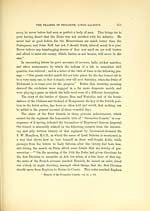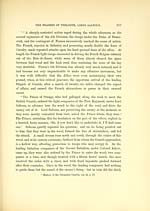Frasers of Philorth > Volume 1
(326)
Download files
Complete book:
Individual page:
Thumbnail gallery: Grid view | List view

254 THE FRASERS OF PHILORTH, LORDS SALTOUN.
at half-past one in the morning of the 16th. The drams immediately beat
to arms, and at two the Guards, having assembled at Hove, were ready to
move off. At four o'clock they commenced their march, the First Brigade
leading, preceded by its light companies under Lord Saltoun. Their route
led them over the position of Steinkirk, rendered famous, 123 years earlier,
by the gallant conduct of their predecessors in 1692, and they reached
Braine-le-Comte at nine in the morning, having been joined on the march by
the second Brigade under Byng. The first Division, after experiencing some
delay in marching through this town owing to its crowded state, halted for
a few hours on its eastern side, while General Cooke, commanding the
Division, made a reconnaissance to the southward. On his return at mid-
day he took upon himself the responsibility of continuing the march of the
Division towards Mvelles, ten miles further, though the heat of the day was
excessive, and the men were suffering from the weight of their packs. The
Division of Guards were therefore again en route, and in due course arrived
at three o'clock at a position within half a mile of Mvelles, where they
expected to rest from their day's march, but they had not halted many
minutes and piled arms, before an aide-de-camp brought an order to advance
immediately. The Division was again under arms, and as it was supposed,
from the firing having become very heavy and apparently very close, that
the enemy was entering Nivelles on the other side, it moved off at the
double down the hill to encounter them. After passing through the town
unopposed, the march was continued to Hautain CarolL where the artillery
was allowed to pass to the front, thence along the chaussee leading to Namur.
During this part of the march many wounded were passed going to the rear,
and a wounded officer of the 44th regiment that was met, urged the quick
advance of the division, as things he said were going on badly for the
Allies. As the march continued, more and more wounded were met on the
road side, telling of the seriousness of the work going on in front ; at last,
about five o'clock in the afternoon, the leading companies of the First Guards,
viz., the Light Infantry under Lord Saltoun, arrived at a critical moment at
the north-western extremity of a wood called the Bois de Bossu, about three-
quarters of a mile long and 300 yards broad, which lay to their right, on the
south side of the chaussee, near Quatre Bras."
at half-past one in the morning of the 16th. The drams immediately beat
to arms, and at two the Guards, having assembled at Hove, were ready to
move off. At four o'clock they commenced their march, the First Brigade
leading, preceded by its light companies under Lord Saltoun. Their route
led them over the position of Steinkirk, rendered famous, 123 years earlier,
by the gallant conduct of their predecessors in 1692, and they reached
Braine-le-Comte at nine in the morning, having been joined on the march by
the second Brigade under Byng. The first Division, after experiencing some
delay in marching through this town owing to its crowded state, halted for
a few hours on its eastern side, while General Cooke, commanding the
Division, made a reconnaissance to the southward. On his return at mid-
day he took upon himself the responsibility of continuing the march of the
Division towards Mvelles, ten miles further, though the heat of the day was
excessive, and the men were suffering from the weight of their packs. The
Division of Guards were therefore again en route, and in due course arrived
at three o'clock at a position within half a mile of Mvelles, where they
expected to rest from their day's march, but they had not halted many
minutes and piled arms, before an aide-de-camp brought an order to advance
immediately. The Division was again under arms, and as it was supposed,
from the firing having become very heavy and apparently very close, that
the enemy was entering Nivelles on the other side, it moved off at the
double down the hill to encounter them. After passing through the town
unopposed, the march was continued to Hautain CarolL where the artillery
was allowed to pass to the front, thence along the chaussee leading to Namur.
During this part of the march many wounded were passed going to the rear,
and a wounded officer of the 44th regiment that was met, urged the quick
advance of the division, as things he said were going on badly for the
Allies. As the march continued, more and more wounded were met on the
road side, telling of the seriousness of the work going on in front ; at last,
about five o'clock in the afternoon, the leading companies of the First Guards,
viz., the Light Infantry under Lord Saltoun, arrived at a critical moment at
the north-western extremity of a wood called the Bois de Bossu, about three-
quarters of a mile long and 300 yards broad, which lay to their right, on the
south side of the chaussee, near Quatre Bras."
Set display mode to:
![]() Universal Viewer |
Universal Viewer | ![]() Mirador |
Large image | Transcription
Mirador |
Large image | Transcription
Images and transcriptions on this page, including medium image downloads, may be used under the Creative Commons Attribution 4.0 International Licence unless otherwise stated. ![]()
| Histories of Scottish families > Frasers of Philorth > Volume 1 > (326) |
|---|
| Permanent URL | https://digital.nls.uk/96569412 |
|---|
| Attribution and copyright: |
|
|---|
| Description | A selection of almost 400 printed items relating to the history of Scottish families, mostly dating from the 19th and early 20th centuries. Includes memoirs, genealogies and clan histories, with a few produced by emigrant families. The earliest family history goes back to AD 916. |
|---|

